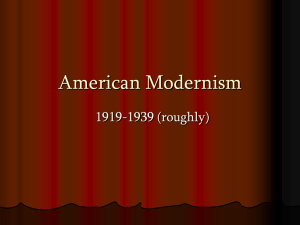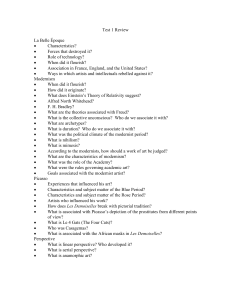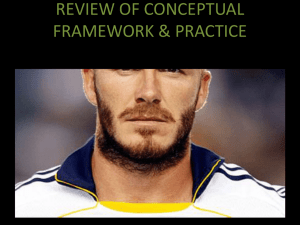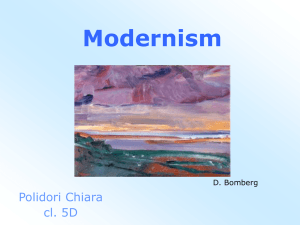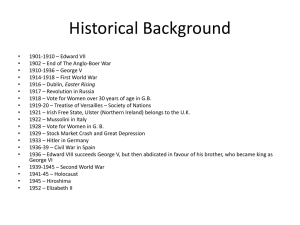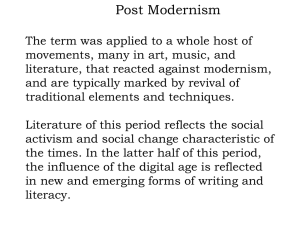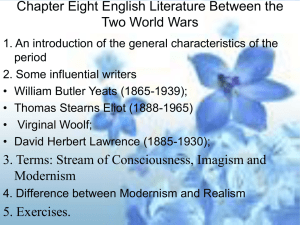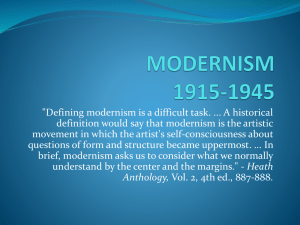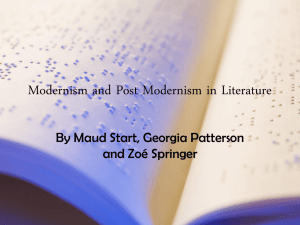English Literature Period Course 1880-1940
advertisement
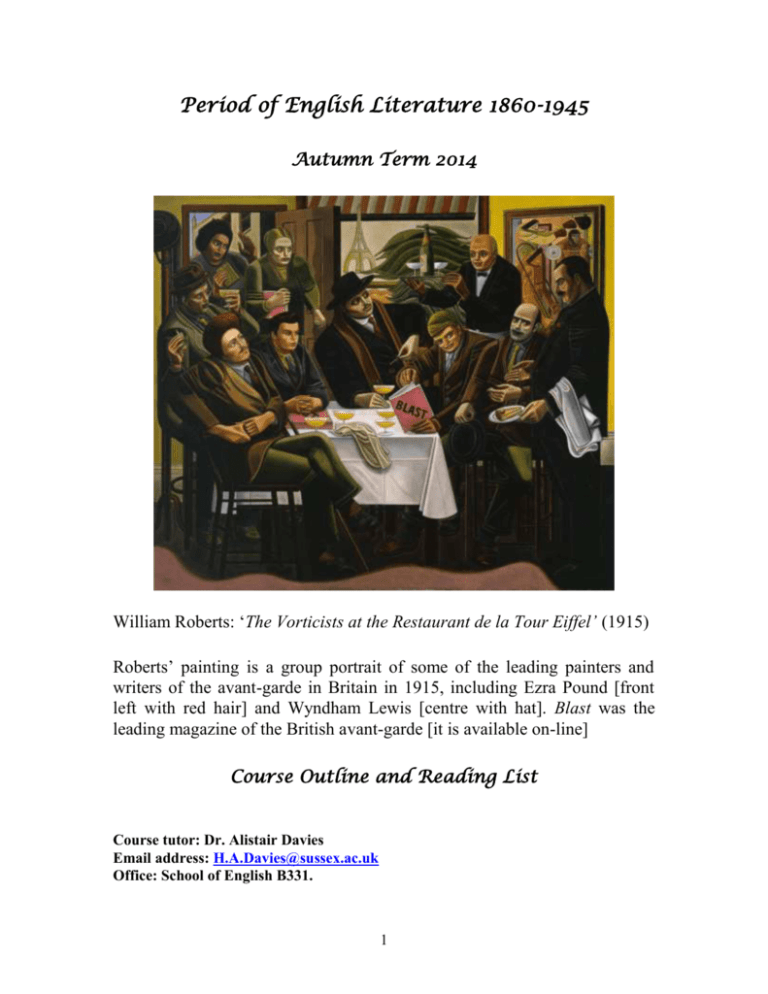
Period of English Literature 1860-1945 Autumn Term 2014 William Roberts: ‘The Vorticists at the Restaurant de la Tour Eiffel’ (1915) Roberts’ painting is a group portrait of some of the leading painters and writers of the avant-garde in Britain in 1915, including Ezra Pound [front left with red hair] and Wyndham Lewis [centre with hat]. Blast was the leading magazine of the British avant-garde [it is available on-line] Course Outline and Reading List Course tutor: Dr. Alistair Davies Email address: H.A.Davies@sussex.ac.uk Office: School of English B331. 1 Syllabus rubric: The course involves the intensive study of a limited period of English Literature. The student will encounter new material, and, in some cases, will tackle in greater depth some material already studied, addressing questions of literary history and theory, form and rhetoric. It is intended that the study of the period will not confine itself to major authors only; it will involve the consideration of themes and topics appropriate to the period and will include material drawn from various literary genres. Teaching method: One seminar per week, with student presentations [which will be part of your formal assessment]. The seminar will address primary and secondary texts and offer the opportunity for close textual analysis. There is a lecture series on some of the literature you will be reading and on the contexts of your 1860-1945 course. You are expected to attend this. You will receive as an electronic resource a compendium I have prepared for the seminars and lectures in the course. Essay requirements: One essay is required for this course. The length and date for the submission of this essay will be found on Sussex Direct. Note that footnotes and bibliography are not included in the word length for your essay. You will also have an unseen examination. Oral Presentation: Students are required to give an oral presentation during this course because students are awarded marks for this and for their participation in and contribution to seminar discussion. You will be given guidance about presentations at the beginning of the course. In arriving at the overall mark for your presentation, your tutor will also consider your participation in seminar discussion, particularly your engagement with the issues raised by your fellow students in their presentations. Final assessment: Times of assessments and proportions of assessment – for your essay, your presentation and your unseen - within the unit are available on the course assessment details are given on Sussex Direct. Official information on assessment is given in the Handbook for Candidates. You should note that the information published by the Undergraduate Office is the official information; requirements cannot be varied by any individual member of faculty or examiner. Any candidate receiving contrary or erroneous information should check with the Undergraduate Office, since receipt of such information will not be seen as an acceptable reason for failing to comply with the published instructions. 2 English Literature 1860-1945 We are studying on this course one of the truly momentous periods of British political, social and cultural history. We begin in the mid-Victorian period when British financial, commercial and military power was at its height. We end with the conclusion of a second World War which brought about the end of British economic and political hegemony. We will need to focus on imperialism and its conflicts, the growth of nationalism, war, technological change, fundamental social and political transformations, shifts in the relationships between the sexes, the development of consumerism, the creation of the mass press, the radio and cinema, the emergence of anarchism, socialism, communism and fascism; the questions raised by two devastating wars: these will provide some of the contexts for our reading and your lectures. There were also revolutionary intellectual changes as well: the impact of Darwinism; the development of psychology and psychoanalysis; the philosophical quest for new valuesystems as a response to the nineteenth-century crisis of doubt. This was also the period in which writers and intellectuals concerned themselves with finding new vocabularies to describe the body and sexuality. It is perhaps not surprising that the collision of these external and internal transformations should have produced some of the most demanding and interesting works of literature in English. We will examine the links between Victorian modernity and modern/modernist literature and focus on changing definitions in writing of the subject and of subjectivity. I’ve framed our course through three major concepts – sexualities, nationalities and temporalities – but these are not all-exclusive and merely offer a reminder of some of key concepts of our period. In the literature we shall study, we shall find many of the key cultural issues of the period: the question of origins, the consequences of science and technology, (modernisation, urbanisation, sub-urbanisation); definitions and re-definitions of Englishness; the invention of traditions; the critique of modernity; the fate of liberalism, with particular reference to literary characterisation; the impact of photography, the mass media and new forms of communication from the telephone to the motor car. There are a number of works which give a useful over-view of the period: Andrew Sanders: ‘Late Victorian and Edwardian Litertature 1880-1920’ and ‘Modernism and Its Alternatives’ in The Short Oxford History of English Literature; Malcolm Bradbury and J.W.McFarlane (eds): Modernism 1890-1930; Michael Bell: The Context of English Literature 1900-1930. See also the Period Compendium for further recommended reading. For an important feminist revisionist reading of the period, see the three volume study by Sandra Gilbert and Susan Gubar: No Man’s Land: the Place of the Woman Writer in the Twentieth Century, vols 1-3. For a useful discussion of modernist fiction, see Randall Stevenson: Modernist Fiction. For an indispensable series of background essays to the period, see David Bradshaw (ed): A Concise Companion to Modernism. You will find Terry Eagleton’s recent The English Novel extremely stimulating in its discussion of the novelists of this period. You will find copies of Talia Schaffer’s useful compendium Literature and Culture in the Fin de Siècle in short loan. 3 1. The Condition of England and the Condition of England Novel George Eliot: Middlemarch: A Study of Provincial Life (1871) [Buy OUP World Classics edition] John Ruskin: ‘The Nature of Gothic,’ in Compendium A. See also Matthew Arnold: 'Dover Beach' (1867) and ‘Hebraism and Hellenism’ in The Victorian and Post-Victorian Crisis of Belief in Compendium A. We begin by reading one of the most celebrated “condition of England” novels in the English tradition. Eliot makes use of this genre where the novelist moves beyond the usual concerns of the English social novel with marriage and inheritance to reflect on the political, social and intellectual conditions of the nation in which she lived. It is important that the text is set during the struggles leading up to the first Reform Bill in 1832; and that it is set in the provinces since the tensions between provincial and metropolitan life were important in the nineteenth century as the North and the Midlands saw the emergence of wealth and power to set aside the financial wealth and power of the capital. The century is one marked by the increasing influence of the middle classes (empowered by the first Reform Bill), the decline in the authority of the land-owning aristocracy, the emergence of an organized working-class and the growth of the great provincial cities – Manchester, Birmingham, Glasgow. We will read the novel alongside the intellectual debates of the period – the crisis of faith, the decline in traditional Christian belief, the challenge to authority, the emergence of science, the effects of the Darwinian revolution in thought. The mid-Victorian period is at once a period of great confidence and a period of challenge and doubt. Matthew Arnold’s “Dover Beach” (1867) expresses the crisis of faith of the period while the aesthetic and social criticism of John Ruskin provided for many the terms for the aesthetic and social critique of Victorian commercial and industrial Britain. Ruskin’s fascination with the Gothic – a fascination shared by those building the great public buildings of the nineteenth century – enables us to understand the bifocal nature of Victorian literary culture: its intense engagement with modernity, with the present and its intense awareness of the past, of past cultures and systems of belief. Ruskin was a Tory but his ideas proved an inspiration to those on the left who were seeking utopian solutions to mitigate the effects of nineteenth century urban and industrial life. In News from Nowhere (1891), William Morris imagined a future London without the modern developments of the present century (although others, including Richard Jeffries (After London, 1885) and H.G.Wells in The Time Machine, foresaw apocalyptic and catastrophic futures for modernity). The debates of the mid-Victorian period carry over into the twentieth century and many are still with us today. We may think we have in many ways surpassed the Victorians but their intellectual and literary preoccupations (including the “condition of England” novel) remain still vibrant today, not least the concern with the relationship between aesthetics and politics. *Terry Eagleton: ‘George Eliot’ in The English Novel, pp. 163-186. George L.Levine (ed.) The Cambridge Companion to George Eliot 4 Gillian Beer: Darwin’s Plots: Evolutionary Narrative in Darwin, George Eliot and Nineteenth-Century Fiction. A. Mintz: George Eliot and the Novel of Vocation David Carroll: George Eliot and the Conflict of Interpretations A.D.Nuttall: Dead from the Waist Down: Scholars and Scholarship in Literature and the Popular Imagination. Week 2: The Modernist Condition of England Novel D.H.Lawrence: The Rainbow (1915) [Buy the Penguin edition] Lawrence was, like Eliot, a provincial writer (a writer born and bred in the provinces – the East Midlands, like Eliot) and concerned with the differences between provincial and metropolitan (that is, London) life. For our period London is both a phenomenon (the largest city in the world), the centre of political, social and cultural power and a place of loss and alienation. Lawrence modeled himself on Eliot in writing The Rainbow which begins in the 1840s and represents three generations within the Victorian period. The modernists saw themselves as heirs to the Victorians and yet as reacting against many of the values of the Victorian period. What makes The Rainbow such an important text is the fact that it expresses a critique of the effects of industrialization – on nature and on those working in industry – which echoed a long tradition from the Romantic poets through a host of Victorian thinkers from Carlyle to Ruskin and William Morris. In this week, we will compare and contrast Middlemarch and The Rainbow as condition of England novels. Raymond Williams’ classic Culture and Society provides an excellent account of the critical nature of Romantic and Victorian thought. Terry Eagleton:’D.H.Lawrence’ in The English Novel Stephen Kern: The Culture of Love: Victorians to Moderns Tony Pinkney: D.H.Lawrence Anne Fernihough (ed) The Cambridge Companion to D.H.Lawrence Michael Bell: D.H.Lawrence: language and being Patricia D. Tobin: Time and the Novel: the Genealogical Imperative Allan Ingram: The Language of D.H.Lawrence Anne Smith (ed): Lawrence and Women Michael Ragussis: The Subterfuge of Art: Language and the Romantic Tradition Michael Black: Lawrence’s England: the Major Fiction, 1913-20. Joseph Allen Boone: 'Channelling the Floods of Desire' in Libidinal Currents: Sexuality and the Shaping of Modernism Earl G.Ingersoll: D.H.Lawrence: Desire and Narrative. Peter Widdowson (ed): D.H.Lawrence Petra Rau: ‘Monster Men and Women’: Woolf’s Groteque German Body and Lawrence’s Bad Modernity,’ in English Modernism, National Identity and the Germans, 1890-1950. Jesse Wolfe: ‘The Love that cannot be escaped’ in Bloomsbury, Modernism and the Reinvention of Intimacy, pp. 115-140. 5 Frank Kermode: D.H.Lawrence Evelyn Cobley: Modernism and the Culture of Efficiency. Paul Sheehan: Modernism, Narrative and Humanism Charles Ferrall: Modernist Writing and Reactionary Politics Frank Kermode: The Sense of an Ending David Seelow: Radical Modernism and Sexuality: Freud/Reich/Lawrence and Beyond James C. Cowan: D.H.Lawrence: Self and Sexuality Week 3: From the Pre-Raphaelites to the Decadents: the first Avant-Garde? Dante Gabriel Rossetti: ‘Proserpine’ (1874) Algernon Charles Swinburne: ‘Hymn to Proserpine’ (1873) [in compendium A, 8-9] Walter Pater: ‘Conclusion,’ The Renaissance [in compendium A, 38-40] Oscar Wilde’s ‘Symphony in Yellow’ [in compendium A, 49] Gerard Manley Hopkins: ‘God’s Grandeur’; ‘The Windhover’; ‘Binsley Poplars’; ‘Felix Randal’; [handout] and ‘The Wreck of the Deutschland’ [compendium A, 14-22] Oscar Wilde: The Picture of Dorian Gray Decadence was a movement in English Literature inspired by the French – by the poetry of Charles Baudelaire whose work Algernon Swinburne introduced to the English and by the fiction of J.K.Huysmans whose Against Nature (1884) was the poisonous yellow book referred to in Oscar Wilde’s The Picture of Dorian Gray. It is important that you read this short text to see how extravagant and anti-female the Decadent movement was. 6 The Decadents were the forerunners of the Aesthetic movement and we will look at the similarities and differences between the Decadents and the Aesthetes. We will read Oscar Wilde’s poems alongside Algernon Swinburne and Walter Pater [see the compendium], the poems of Gerard Manley Hopkins and a number of pre-Raphaelite paintings. The pre-Raphaelites were the first English avant-garde, with leading figures such as Dante Gabriel Rossetti accomplished both as painters as well as writers. William Morris was a leading designer as well as writer. We need to get this movement in focus because this was the first movement to place beauty and the question of aesthetics at the forefront of their work and anticipated the second stage of aestheticism associated with Pater and with Wilde. John Ruskin was the leading advocate of the first aestheticist movement – which was founded in 1848 and remained active well into the last decade of the nineteenth century and beyond. Simeon Solomon: ‘Bacchus’ (1867) Wilde was an Irish-born writer; his works are concerned with questions of language and of class; and they represent two (non-realistic) poles of dramatic and fictional writing in the late nineteenth and early twentieth century. Does a society become self-conscious about class, social role and identity at a time when it is undergoing rapid and widespread transformation? Britain’s changing identity as an imperial power in this period can be explored through the relationships between England and Ireland, but it is important to start with the realization that the 1890s was both a period in which the empire seemed at its height and a period in which anxieties about the fitness to rule were everywhere in the culture, as we can see from Kipling’s ‘Recessional’ (1897). The Wilde trial in 1895 precipitated all kinds of concerns about manliness and decadence and the intense homophobia of the following fifteen years made many closeted gay writers from Henry James to E.M.Forster anxious about their possibilities of expression. Swinburne’s ‘Hymn to Proserpine’ [see compendium] is an important forerunner for the decadent movement, with its celebration of pagan sensuality and its attack on Christianity. Wilde was influenced by his tutor Pater at Oxford. How did his ideas have an impact on Wilde’s writing? How does Wilde make use of language in his writing? See J.D.Rosenberg’s brilliant discussions of Pater in Elegy for an Age: The Presence of the Past in Victorian Literature. For the best general discussion of Aestheticism and Decadence, see Murray G.Pittock’s chapter ‘Decadent P(r)ose’ in his Spectrum of 7 Decadence. For a more demanding but equally indispensable account, see ‘Aestheticism’ in Jonathan Freedman: Professions of Taste: Henry James, British Aestheticism and Commodity Culture. For a brilliant placing of aestheticism in relation to the new consumerism, please read Rachel Bowlby’s essay ‘Promoting Dorian Gray’ in her Shopping with Freud. See also the sections The Modern Self: Romantic and Modern, Aestheticism and Decadence and Gay Culture and Gay Identity 1880-1940 in the Period Compendium. Rachel Bowlby; ‘Promoting Dorian Gray,’ in Shopping with Freud Murray G.Pittock: ‘Decadent P(r)ose,’ Spectrum of Decadence Jonathan Freedman: ‘Aestheticism’ in Professions of Taste: Henry James, British Aestheticism, and Commodity Culture Stephen Calloway: ‘Wilde and the Dandyism of the Senses,’ in Peter Raby (ed) The Cambridge Companion to Oscar Wilde Joseph Bristow: ‘A complex multiform creature: Wilde’s sexual identities’ in Peter Raby (ed) The Cambridge Companion to Oscar Wilde Regenia Gagnier: 'Wilde and the Victorians' and Jeruska McCormack: ‘Wilde’s Fiction(s) in Peter Raby (ed) The Cambridge Companion to Oscar Wilde Patrick Parrinder: Shadows of the Future: H.G.Wells, Science Fiction and Prophecy. Richard Dellamora: Masculine Desire: the Sexual Politics of Victorian Aestheticism Sandra Gilbert and Susan Gubar: No Man's Land: vol 2 Sexchanges Eve Kosofsky Sedgwick: Between Men: English Literature and Male Homosocial Desire Eve Kosofsky Sedgwick: Epistemology of the Closet Chris White: Nineteenth Century Writing on Homosexuality: A Sourcebook John Stokes (ed): Fin de siècle: Fin du globe Sally Ledger and Roger Luckhurst: The Fin de Siècle: A Reader in Cultural History 1880-1900 Mikulas Teich and Roy Porter: Fin de Siècle and Its Legacy Sally Ledger and Scott McCracken (eds): Cultural Politics at the Fin de Siècle Linda Dowling: The Vulgarization of Art: the Victorians and Aesthetic Democracy Perry Meisel: The Myth of the Modern: A Study in British Literature and Culture after 1850 Declan Kiberd: Inventing Ireland (section on Wilde) 8 Week 4: Evolution, Decadence and Determinism Thomas Hardy: Jude the Obscure (1895) Algernon Swinburne: ‘Hymn to Proserpine’ in Compendium A Thomas Hardy: ‘Beeny Cliff’ (in Compendium A) How does Hardy's novel relate to those of Austen, Dickens, George Eliot and Henry James you may have read? What are Hardy's principal modes of characterisation? What kind of novel has he written? We shall examine the impact of Darwinism both on the form and the content of Hardy's novel and we shall examine the impact of the crisis of Christianity too. Hardy’s faith was shaken by reading Swinburne’s “Hymn to Proserpine” (as is the faith of Jude and Sue in the novel.) We shall look at Hardy's representation of nature, women, marriage and class. How is Sue Bridehead linked to the idea of the New Woman? Why does Christminster [Oxford] figure so centrally in the desire and the disappointment of Jude? How do Ruskin’s ideas about the Gothic and about workmanship figure in the novel? What is Hardy's image of community within the novel and how does this reflect the imagined community of readers? For an excellent and lucid account of the idea and the reality of Victorian Oxford, see John D.Rosenberg: ‘The Oxford Elegists: Newman, Arnold, Hopkins,’ Elegy for an Age: The Presence of the Past in Victorian Literature. If the 1860-1945 period can be seen as a period of profound changes in sexualities – the visibility of gay culture, the challenge to marriage, the promotion of free love – it is also a period when notions of time and of history become paramount. The Victorian period was the period concerned with origins – in language, biology, anthropology, sociology and religion – and it was a period attempting to assimilate the findings of Darwin, whose evolutionary theory provided a challenge to the authority of religion and of the church. Hardy’s poetry and fiction is throughout aware of these developments, with its interest in pre-Christian and pagan remnants and its awareness of the crisis into which Darwinian ideas had put Christianity and the social and ideological structures which in Britain the church underpinned. Penny Boumehla: 'The Patriarchy of Class' and Dale Kramer: ‘Hardy and Readers: Jude the Obscure’ in Dale Kramer (ed): The Cambridge Companion to Thomas Hardy Penny Boumehla: Thomas Hardy and Women John Goode: Thomas Hardy: The Offensive Truth Philip Mallett (ed.) The Achievement of Thomas Hardy Patricia Ingham: Thomas Hardy Peter Widdowson: Thomas Hardy: Late Essays and Earlier Patrick Parrinder: Nation and Novel Terry Eagleton: ‘Thomas Hardy’ in The English Novel Ariela Freedman: Death, Men and Modernism Angelique Richardson: 'The Life Sciences: "Everybody nowadays talks about evolution"' and David Bradshaw: 'Eugenics: "They should certainly be killed" in David Bradshaw (ed): A Concise Companion to Modernism, pp. 6-33; pp.34-55. 9 Week 5: Deep Past and Far Future in Tales of Adventure Joseph Conrad: Heart of Darkness (1899) H.G.Wells: The Time Machine (1895) [You can read this as an e-text] Henri Labouchère:‘The Brown Man’s Burden’ (1899), pp.105-6 of Period Compendium [See also: Rudyard Kipling: ‘Recessional’ and ‘The White Man’s Burden’ and Henry Newbolt: ‘Vitai Lampada’ in compendium A] Evolutionary theory speaks of the struggle for survival and about the means of adaptation. But it also implies that races or groups can regress as well as evolve. How do these two texts explore the notion of human regression – going backwards even in the process of going forwards? By the end of the nineteenth century, Britain was the first country to achieve mass literacy. This provided a huge market for writers who used many different genres - the ghost story, the tale of imperial adventure, the comic tale, the mystery, the detective story - to satisfy the reading public. The short story and the longer novella were key forms because they could be read while commuting to work or taking a break. This week we shall read two novellas and one short story, all of which use popular forms but employ them in highly complex ways. How are these tales narrated? How reliable are their narrators? How reliable do we find a first person narrator? What are the advantages and the disadvantages of first-person narration? To what extent does the use of a specific narrative technique raise questions about the limits of human knowledge (and of human self-knowledge)? What are the links in these texts between narration and gender? How do the novels reflect upon British imperialism and upon the British ruling class? How do these tales reflect upon late Victorian race theory or early twentieth century imperial society? Phillip Blom: *‘1904: His Majesty and Mr Morel’ and ‘1912: Questions of Breeding’ in The Vertigo Years: Change and Culture in the West, 1900-1914. William Greenslade: Degeneration, Culture and the Novel, 1880-1940. I.P.Watt: Conrad in the Nineteenth Century Chinua Achebe: ‘An Image of Africa’ in Massachusetts Review 18: 4 (1977) [This is reprinted in Bart Moore-Gilbert (ed.) Postcolonial Criticism] Cedric Watts: (ed) Conrad’s Heart of Darkness Cedric Watts: The Deceptive Text Cedric Watts: A Preface to Conrad Edward Said: ‘Heart of Darkness and the Histories of Empire,’ in Culture and Imperialism John A McClure: Kipling and Conrad Terry Eagleton: ‘Joseph Conrad’ in The English Novel 10 Week 6: Modernisms/Avant-Gardes: ‘Make It New’ Please read the material on Dadaism in the 1860-1945 course compendium B Ezra Pound: The Cathay Poems (1915) [you can read and hear these on-line] W.B.Yeats: Selected Poems [handout] The lecture series will introduce you to the European contexts of the avant-garde, particularly Dadaism and Surrealism. You will find Andre Breton’s Nadja (1928) a useful text for understanding the development of European surrealism and the lecture series and 1860-1940 course compendium will introduce you to some of the major works of Dadaism. This is important background which will enable us to define the very different trajectories of the English avant-garde in the same period, associated with Wyndham Lewis, Ezra Pound and T.S.Eliot. By reading W.B.Yeats, we will consider competing definitions of ‘modernism’ and ‘the avant-garde’. London just before the outbreak of the First World War was the site of the belated but no less dynamic English avant-garde, even if its leading figures, Ezra Pound, Jacob Epstein, Henri Gaudier-Brzeska, Hilda Doolittle, Wyndham Lewis, James Joyce, Ezra Pound, Mina Loy and T.S.Eliot were foreign. We shall focus on the poetic relationship between W.B.Yeats, who had been writing since the late 1880s and Ezra Pound – who had come to London in order to meet Yeats and ended up becoming his literary secretary from 1913-1915. Pound shared many of Yeats’ interests in classical European and Eastern cultures and shared too his view of the public function of the poet as a special consciousness, the bearer of the significant memories of the culture. Pound, with his concern to rid poetry of rhetoric and bombast, was concerned with emulating Easternstyle directness and simplicity (hence his interest in classical Chinese poetry). He helped Yeats to make his poetic writing more direct but Yeats encouraged Pound to admire aristocratic forms of government and life. We will set some of Yeats’ poems about female figures alongside Mina Loy’s more experimental and feminist poetry. Pericles Lewis’s recent The Cambridge Introduction to Modernism is excellent – see ‘The Avant-Garde and High Modernism’ - and you will find his discussion of the origins of modernism in the work of Charles Baudelaire and in the response to the city stimulating for your work in general on the different concepts of modernism and of the avant-garde. So too is the new Cambridge Companion to Modernist Poetry, edited by Alex Davis and Lee M.Jenkins. This contains very fine essays on English and American modernist poets and on the different and competing schools of modernist poetics. Please read Pericles Lewis’ article on modernism and Great War you will find on the Study Direct site for the course. *Peter Bűrger: ‘Avant-Gardiste Work of Art’ in Theory of the Avant-Garde, pp.55-82. *Hugh Kenner: ‘The Invention of Language’ in The Pound Era Pericles Lewis: The Cambridge Introduction to Modernism Michael J.K.Walsh (ed.) London, Modernism and 1914 11 *George Bornstein: ‘Pound and the Making of Modernism’, Hugh Witemeyer: ‘Early Poetry, 1908-1920’ and Helen M.Dennis: ‘Pound, Women and Gender’ in Ira B.Nadel: The Cambridge Companion to Ezra Pound, pp. 22-42 , pp. 43-58 and pp. 264-283. Rebecca Beasley: Ezra Pound and the Visual Culture of Modernism Rupert Arrowsmith: Modernism and the Museum: Asian, African and Pacific Art and the London Avant-Garde Peter M.Sacks: '"In Memory of Major Robert Gregory",' in The English Elegy. D.A.Harris: Yeats: Coole Park and Ballylee Graham Hough: ‘W.B.Yeats’ in The Last Romantics Stephen Regan: 'W.B.Yeats and Irish Cultural Politics in the 1890s' in Sally Ledger and Scott McCracken (eds): Cultural Politics at the Fin de Siecle Seamus Deane: ‘Yeats and the Idea of Revolution,’ in Celtic Revivals Lucy McDiarmid: Saving Civilization: Yeats, Eliot and Auden between the Wars Michael Tratner: '"The Birth of a New Species of Man ..from Terror": Yeats's Poetics of Violence,' in Modernism and Mass Politics Connor Cruise O’Brien: ‘Passion and Cunning: An Essay on the Politics,’ in A.Norman Jeffares and K.G.W.Cross (eds) In Excited Reverie Edward Malins: A Preface to Yeats Patrick J.Keane: Yeats' Interaction with Tradition Richard Ellmann: The Identity of Yeats Elizabeth Cullingford: Gender and History in Yeats' Love Poetry Marjorie Howes: Yeats' Nations: Gender, Class and Irishness Research Break week 7 [This will enable you to research for and write your first essay and to read ahead for the second half of the course in the spring term.] Wyndham Lewis: ‘A Battery Shelled’ (1919) 12 Week 8: Modernism: Make It New/Make It Now Imagist poems and short stories in course compendium B T.S.Eliot: ‘The Love Song of J.Alfred Prufrock’ (1915) T.S.Eliot: ‘Preludes’ (1917) T.S.Eliot: The Waste Land (1922) T.S.Eliot: ‘Tradition and the Individual Talent’ in compendium A, 41-5 Virginia Woolf: ‘Kew Gardens’ (1919) [compendium A, 127-30] Hope Mirrlees: ‘Paris’ (1919) [e-text] We will explore “stream of consciousness” in the dramatic monologue of T.S.Eliot, the short story of Virginia Woolf and the extracts from James Joyce’s Ulysses. Published in 1922, Eliot’s The Waste Land defined for many of the literate young who had grown up through the war their sense of the immensity of the catastrophe and the depth of the consequence of the war: not just in the revolutions and collapses of empires and regimes seen in most of Europe but also in the brutalizing of affect and the destruction of illusions about European culture and society. Yet its collage system is anticipated by Woolf and its radicalism is anticipated in Hope Mirrlees’ Paris. [See the brief discussion of this poem on the Yale Modernism Lab website.] James Joyce’s Ulysses appeared in the same year, the “wonder year” of 1922. Eliot is preoccupied with the destruction of traditional social, cultural and religious modes of communication and sense-making in and through the war – which they both see as the revelation or summation of ‘modernity’: technology, mechanization, mass society, the separation of community and communal understanding from nature and from natural processes. Is his work a work of modernism or of the avant-garde? We will focus on Eliot and Joyce as writers of the city, geographers of the city past and present; we will consider their use of myth to structure their works; and we will consider the significance of the moment, of the instant, in modernist writing. Eliot’s The Waste Land was for many the key literary response to the First World War. What was it that made this arguably the most influential literary text in British elite culture in the period? How did it contribute to the idea that we lived in a modern ‘waste land’, an idea taken up by many of the most significant writers, painters and photographers of the 1920s and 1930s, including W.H.Auden’. You may wish to read this poem in the new annotated Yale edition, edited by Lawrence Rainey [there are many copies in short loan.] If you cannot find this in short loan, read your poem with B.C.Southam: A Student’s Guide to the Selected Poems of T.S.Eliot as your guide. But read first without any gloss to see what impact the poem has upon you in your first reading. [See below for secondary material on Joyce.] *James Longenbach: ‘Modernist Poetry’ in Michael Levenson (ed.): The Cambridge Companion to Modernism [this is a wonderful essay, please make every effort to read it] Jon Stallworthy: ‘The iconography of The Waste Land’ in Survivors’ Songs Paul Fussell: The Great War and Modern Memory [see discussions of Eliot]. 13 Edward Timms and David Kelley (ed): Unreal City Andrea Zemgulys: ‘In London with a Baedeker: touring T.S.Eliot’s Waste Land,’ in Modernism and the Locations of Literary Heritage, pp. 126-144. Christopher Butler: ‘The Modernist Self’ and ‘The City’ in Early Modernism Sandra Gilbert: ‘”Rats Alley”: the Great War, Modernism and the Anti (Pastoral) Elegy,’ New Literary History, 30:1 (1999), 179-201 [via Electronic Journals]. Sarah Cole: ‘Friendship and Comradeship at War,’ in Modernism, Male Friendship and the First World War Stephen Spender: Eliot: Modern Masters Angus Calder: T.S.Eliot: New Readings A.D.Moody (ed): The Cambridge Companion to T.S.Eliot Frank Lentricchia: ‘T.S.Eliot,’ in Modernist Quartet Christopher Butler: ‘The Modernist Self’ and ‘The City’ in Early Modernism A.D.Moody: Thomas Stearns Eliot: Poet Michael Levenson: ‘The Waste Land,’ in a Genealogy of Modernism Maud Ellmann: The Poetics of Impersonality Ruth Nevo: ‘The Waste Land: Ur-Text of Deconstruction,’ in New Literary History, 13:3 (Spring 1982). Marcel Duchamp: Mona Lisa (1919) 14 Week 9: Feminist Modernism Virginia Woolf: To the Lighthouse (1927) Woolf’s generational novel can be placed in comparison with Lawrence’s. How does she deal with time and history, the passage of time and the disruption of the war? Like Lawrence’s text, this is also a novel about families, the unconscious, the relation to patriarchy and the positive powers of the feminine. What reading modes do you need to adopt in order to make sense of the text? How does the artist figure in the novel reflect upon art-making and upon the role of the artist? How is this novel an elegy, an act of mourning? Rachel Bowlby: Feminist Destinations and Further Essays on Virginia Woolf Christina Froula: Virginia Woolf and the Bloomsbury Avant-Garde: War, Civilization, Modernity. Gillian Beer: 'Hume, Stephen and Elegy in To the Lighthouse,' 'The Body of the People: Mrs Dalloway and The Waves,' and 'The Life of Anybody,' in Virginia Woolf: the Common Ground Sandra Gilbert and Susan Gubar: No Man’s Land: vol 3 Jesse Wolfe: Bloomsbury, Modernism and the Reinvention of Intimacy. Jed Esty: ‘Insular Rites: Virginia Woolf and the Late Modernist Pageant-Play’ in A Shrinking Island: Modernism and National Culture in England Vincent Sherry: ‘Woolf, among the modernists,’ The Great War and the Language of Modernism. Suzanne Raitt: Virginia Woolf's 'To the Lighthouse' Pamela Caughie: 'Virginia Woolf and Postmodernism: Returning to the Lighthouse,' in Kevin J.H.Dettmar (ed): Rereading the New John Mepham: Virginia Woolf: A Literary Life Makiko Minow-Pinkney: Virginia Woolf and the Problem of the Subject Heather Ingman: 'Virginia Woolf: Retrieving the Mother,' in Women's Fiction Between the Wars Carolyn Dever: ‘Virginia Woolf’s “Victorian Novel”’ in Death and the Mother from Dickens to Freud. Jane Marcus: Virginia Woolf and the Language of Patriarchy Bette London: The Appropriated Voice: Narrative Authority in Conrad, Forster and Woolf Sue Roe: Writing and Gender: Virginia Woolf's Writing Practice Elizabeth Abel: Virginia Woolf and the Fictions of Psychoanalysis Marina MacKay: ‘Virginia Woolf and the pastoral patria’ in Modernism and World War II Michael Tratner: 'Ideology and Literary Form in The Waves,' Modernism and Mass Politics Patricia Rae (ed.): Modernism and Mourning. Angeliki Spiropoulou: Virginia Woolf: Modernity and History 15 Week 10 Bloomsbury, Empire and Personal Relations E.M.Forster: A Passage to India (1924) We shall examine the most celebrated anti-imperialist novel of the inter-war period. To what extent is it shaped by the ethical, aesthetic and political values of the Bloomsbury Group? To what extent does it succeed in representing both the British and the Indians in India? To what extent is it caught within its own unquestioned colonialist assumptions? To what extent does it reflect the impact of the First World War? To what extent does Forster try to put into effect the democratic style of relationship John Addington Symonds describes in his account of Whitman’s poetry in the Gay Culture and Gay Indentiy section of the Period Compendium? David Adams: Colonial Odysseys: Empire and Epic in the Modernist Novel Charu Malik: ‘To expess the subject of friendship: masculine desire and colonialism in A Passage to India,’ in Robert K.Martin and George Piggford (eds): Queer Forster David Ayers: ‘The Politics of Friendship in A Passage to India,’ in English Literature of the 1920s Malcolm Bradbury (ed): A Passage to India Sara Suleri: ‘Forster’s Imperial Erotic,’ in The Rhetoric of English India Arthur Martland: E.M.Forster: Passion and Prose Robert K.Martin and George Piggford (eds) Queer Forster B.Mays: The Modernist as Pragmatist: E.M.Forster and the Fate of Liberalism Sara Suleri: ‘The Geography of A Passage to India,’ in D.Walder (ed): Literature in the Modern World Abdul JanMohamed: ‘The Economy of Manichean Allegory,’ in H.L.Gates (ed): ‘Race’, Writing and Difference Jenny Sharpe: ‘The Unspeakable Limits of Rape,’ in P.Williams and L.Chrisman (eds): Colonial Discourse and Postcolonial Theory Harish Trivedi: Colonial Transactions: English Literature and India Sarah Cole: ‘Forster’s Classical Imagination’ in Modernism, Male Friendship and the First World War Benita Parry: Delusions and Discoveries: India in the British Imagination, 1880-1930 Patrick Parrinder: Nation and Novel Ian Baucom: Out of Place: Englishness, Empire and the Locations of Identity William Roberts: ‘The Return of Ulysses’ (1913) 16 Week 11/12: The Novel and the Avant-Garde James Joyce: Ulysses (1922) Joyce’s novel is the most revolutionary novel in the tradition of the novel in English – because of its innovations in the treatment of time, its development of the stream of consciousness, its explorations of the relationships between the present and the past, its re-working of realism in a highly artificial and structured frame which calls realism into question. It is the portrait of one day in the life of a group of individuals and of a city, Dublin, at a particular time in its history but written and conceived during the crisis of the First World War. Like Lewis’ Tarr, it poses a challenge to the dominant English tradition of the novel derived from Jane Austen and George Eliot and continued by Henry James and E.M.Forster. You are strongly recommended to buy an annotated edition of the novel. The Alma Classics edition is particularly useful . Harry Blamires: The New Bloomsday Book Dan Gifford: Ulysses Annotated Steven Connor: James Joyce Clive Hart: James Joyce’s ‘Ulysses’ Derek Attridge (ed.): The Cambridge Companion to James Joyce Derek Attridge (ed.): James Joyce’s Ulysses: A Casebook Christina Froula: Modernism, Body, Sex and Joyce J.H.Maddox: Joyce’s ‘Ulysses’ and the Assault Upon Character Dominic Manganiello: James Joyce’s Politics Colin MacCabe: James Joyce and the Revolution of the Word Derek Attridge: Joyce’s Effects: On Language, Theory and History Additional seminar on the Modernist Poetry of the 1920s and 1930s: Yeats and Auden: Fascism, Communism and the post-Romantic Lyric W.H.Auden: ‘Consider this and in our time,’ ‘Dover’, ‘Letter to Lord Byron’ [read as etext], ‘Spain 1937’, ‘September 1, 1939,’ ‘In Memory of Sigmund Freud’ and ‘In Memory of W.B.Yeats’, ‘September 1 1939’. You will find all of these on-line and/or in compendium A. As we have seen, Yeats's contribution to the Irish literary Renaissance and to the struggle for home rule and Irish independence was substantial. How did he react both to the Great War and to the Irish Civil War? To what extent were the political positions he occupied – first nationalist, then in the 1920s and 1930s proto-fascist - entailed by his poetics? What part did the aestheticism of Pater, Wilde and Morris play in his formation? What is his relationship to the Anglo-Irish aristocracy and to the culture and politics of the 'great house'? How does he figure the family, the feminine and place in his writing? How do we place him in his Irish colonial and postcolonial context? What are the links between his 17 poetics and political violence? How we do assess his fascist sympathies in the mid1930s? On the one hand, Joyce and Yeats represent very different aspects of Irish and European writing in our period; on the other hand, so do Yeats and Auden. Auden and his generation admired Yeats for making poetry “public” and for engaging with history and with the historical, but they did so from positions on the radical left. In this additional seminar we shall explore the similarities and differences between the verse of Yeats and of Auden while examining Auden’s poetic output from the late 1920s to 1940. Auden achieved literary fame in his early twenties and remained at the centre of English poetic and cultural life throughout the late 1920s and 1930s until he shocked his admirers by leaving for America on the eve of the Second World War. He was immensely gifted in his use of modernist and traditional forms, wrote copiously in different genres, and developed an oblique and coded style to explore his homosexuality (then, of course, a criminal matter) and his alienation from his comfortable, public school, Oxford-educated background. In the mid-1930s, Auden worked with the celebrated documentary filmmaker John Grierson and the G.P.O. film unit, writing the verse commentary for the film Night Mail. How important was Auden's engagement with film and with cinema on his development as a poet? How did he reconcile in his inter-war writing the figure of the poet with political activism? Who was more important for him: Marx or Freud? [You might consider the influence of Sigmund Freud's Civilisation and Its Discontents.] Marsha Bryant: 'The Auden Generation Meets the Documentary Decade' and 'Documentary and Masculinity: Auden and "the Worker" of Industrial Britain' in Auden and Documentary in the 1930s Samuel Hynes: The Auden Generation Stan Smith: W.H.Auden Edward Mendelson: The English Auden Keith Williams: British Writers and the Mass Media 1930-1945 Valentine Cunningham: British Writers of the Thirties Stan Smith: 'Ruined Boys: W.H.Auden in the 1930s' in Gary Day and Brian Docherty (eds.): British Poetry 1900-1950: Aspects of Tradition Edward Callan: Auden: Carnival of the Intellect Frank Kermode: The Sense of an Ending Charles Ferrall: Modernist Writing and Reactionary Politics Roger Griffin: Modernism and Fascism Cecil Beaton: W.H.Auden (1930) 18
